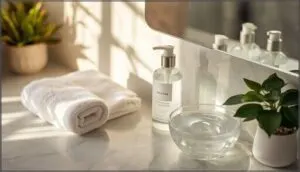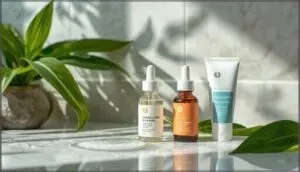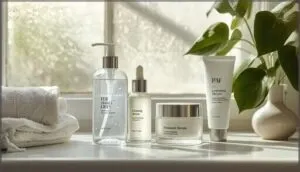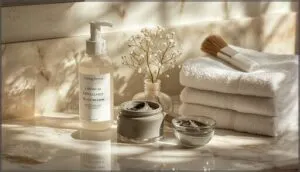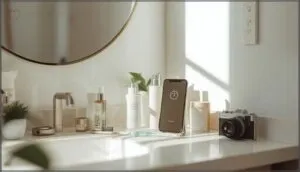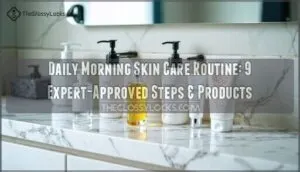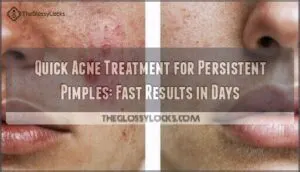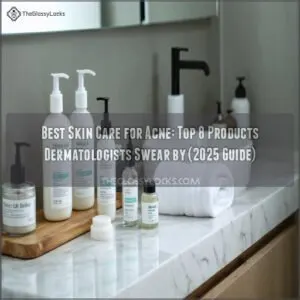This site is supported by our readers. We may earn a commission, at no cost to you, if you purchase through links.
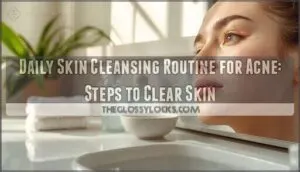 Shiny foreheads and stubborn breakouts have a way of showing up right before the big moments—almost as if your skin’s got its own sense of timing. If you’ve ever felt like your pores have a mind of their own, you’re not alone.
Shiny foreheads and stubborn breakouts have a way of showing up right before the big moments—almost as if your skin’s got its own sense of timing. If you’ve ever felt like your pores have a mind of their own, you’re not alone.
Acne isn’t just a teenage rite of passage; it’s a daily battle for millions, fueled by oil, bacteria, and the tiniest shifts in your routine.
The right daily skin cleansing routine for acne doesn’t just wash away yesterday’s grime—it rewrites your skin’s future, one gentle step at a time. Let’s get into the habits that put you back in control.
Table Of Contents
- Key Takeaways
- What Causes Acne and Daily Breakouts
- How to Identify Acne-Prone Skin
- Essential Steps in a Daily Acne Cleansing Routine
- Key Ingredients for Effective Acne Cleansing
- Step-by-Step Daily Skin Cleansing Routine
- Top 10 Products for Acne-Prone Skin
- 1. Olay Gentle Cleansing Balm Remover
- 2. ZO Skin Health Clarifying Serum
- 3. Neutrogena Fragrance Free Daily Moisturizer
- 4. DRMTLGY Clear Face Sunscreen SPF 45
- 5. The Inkey List Oat Cleansing Balm
- 6. First Aid Beauty Cleansing Oil Remover
- 7. Naturium Niacinamide Gentle Cleansing Gelée
- 8. CeraVe Acne Control Salicylic Cleanser
- 9. Skinfix Ceramide Ectoin Gentle Cleanser
- 10. Acne Free Adapalene Gel Treatment
- Lifestyle Habits to Support Clearer Skin
- Frequently Asked Questions (FAQs)
- Conclusion
Key Takeaways
- Consistent, gentle cleansing morning and night is crucial for preventing clogged pores and breakouts without damaging your skin barrier.
- Look for acne treatments with proven ingredients like salicylic acid, benzoyl peroxide, retinoids, and niacinamide to target oil, bacteria, and inflammation.
- Sticking to your routine and avoiding harsh products or over-cleansing makes treatments more effective and supports long-term skin health.
- Healthy lifestyle habits like proper hydration, balanced diet, stress management, and good hygiene play a big role in supporting clear, acne-free skin.
What Causes Acne and Daily Breakouts
Acne doesn’t just appear out of nowhere—it’s the result of a chain reaction happening beneath your skin’s surface. When you understand what’s actually triggering those breakouts, you can take control instead of feeling helpless.
Let’s break down the key factors that turn clear skin into a battlefield.
How Clogged Pores Trigger Acne
When your pores get blocked, you’re looking at the starting line for acne. Here’s how clogged pores trigger breakouts:
- Microcomedone formation creates tiny plugs invisible to the naked eye—your acne’s ground zero
- Sebum composition shifts, trapping oils and debris inside follicles
- Keratinocyte buildup accumulates dead skin cells that won’t shed properly
- Bacterial infection with C. acnes thrives in blocked, oxygen-starved pores
- Inflammation cascade erupts, turning clogged pores into visible pimples, cysts, or nodules
Gentle cleansing helps prevent this chain reaction before it starts. These blockages can even lead to severe cystic acne.
Role of Oil, Bacteria, and Dead Skin
Acne develops when three factors converge: increased sebum production, proliferation of C. acnes bacteria in follicles, and accumulation of dead skin cells. Each element exacerbates the others—sebum nourishes bacteria, while follicular blockage traps oil and debris inside. Microbiome changes and lipid traits further aggravate the condition. Regular cleansing can disrupt this cycle, preventing pore clogging before bacteria trigger inflammation. As androgen levels increase, sebum production rises, contributing to acne development.
| Component | What It Does | Impact on Your Skin |
|---|---|---|
| Oil (Sebum) | Feeds bacteria, traps debris | Creates breeding ground for breakouts |
| Bacteria (C. acnes) | Inflames follicles, secretes toxins | Transforms clogs into painful lesions |
| Dead Skin Cells | Blocks pores, won’t shed | Locks oil and bacteria inside |
| Combined Effect | Sparks inflammation cascade | Turns invisible plugs into visible acne |
Hormonal and Genetic Influences on Acne
Beyond what’s happening on your skin’s surface, hormonal fluctuations and genetic variants drive much of your acne causes. Androgen excess—found in nearly 18% of adult women with acne—ramps up oil production and triggers skin inflammation.
If your parents battled breakouts, you’re facing 78–81% heritability odds. Familial patterns and hormonal acne aren’t just bad luck—they’ve clinical implications for targeted treatment and long-term skin health.
Common Types and Severity Levels
Your hormonal blueprint can express itself in several distinct forms. Comedonal acne—blackheads and whiteheads—accounts for over 83% of cases and generally stays mild. Inflammatory acne brings red, swollen papules and pustules in roughly 75% of presentations. Nodulocystic acne, the most severe variant affecting under 10%, leaves deep, painful cysts requiring aggressive intervention.
Proper acne grading guides your gentle cleansing strategy and treatment intensity.
How to Identify Acne-Prone Skin
Not all skin is created equal—some faces seem to break out at the slightest provocation, while others stay clear no matter what. If you’re constantly battling breakouts, you’re likely dealing with acne-prone skin, and knowing the signs can help you take control.
Let’s break down what acne-prone skin actually looks like, how to gauge its severity, and what might be setting off your flare-ups.
Signs and Symptoms of Acne-Prone Skin
Your skin’s trying to tell you something when breakouts keep showing up. Acne-prone skin often shows these telltale signs:
- Excess oil production that leaves your face shiny within hours, especially in your T-zone
- Clogged pores appearing as blackheads or whiteheads, most commonly on your forehead and chin
- Inflammation with red, swollen bumps that feel tender to touch
- Irregular skin texture with visible enlarged pores and rough patches
These symptoms help you recognize what your skin needs.
Differences Between Mild, Moderate, and Severe Acne
Understanding where your breakouts fall on the spectrum helps you choose the right acne treatment path. Here’s what each level looks like:
| Severity Level | Lesion Characteristics | Treatment Options |
|---|---|---|
| Mild Acne | Mostly blackheads and whiteheads with few red bumps; under 20 total lesions per face half | Topical retinoids and benzoyl peroxide |
| Moderate | 6–20 inflammatory papules and pustules per face half; visible redness across multiple zones | Combination topicals plus possible oral antibiotics |
| Severe | Over 50 lesions; painful nodules exceeding 5mm; high scarring risks and cystic acne formation | Systemic therapy like isotretinoin required |
Prevalence rates show that moderate cases are the most common, affecting roughly 50% of acne patients, while severe forms impact about 20–30%.
Severity scoring is crucial for dermatologists to match patients with effective therapies. Mild acne typically responds well to gentler treatments, whereas severe breakouts require aggressive intervention to prevent permanent damage.
Recognizing Triggers and Flare-Ups
Your breakouts often tell a story if you know how to read them. Hormonal acne commonly flares along your jawline and chin before periods, when androgen surges spike oil production. Stress effects are real: elevated cortisol directly fuels skin inflammation and acne breakouts.
Dietary impacts matter too—high-sugar meals and excess milk can double your risk. Environmental factors like pollution and hard water weaken your barrier, while product triggers include heavy cosmetics.
Essential Steps in a Daily Acne Cleansing Routine
Getting your cleansing routine right isn’t about fancy steps or expensive tricks—it’s about building a solid foundation that actually works. When you know what to do (and what not to do), you’re already halfway to clearer skin.
Let’s break down the essentials that make or break your daily routine.
Importance of Gentle Cleansing Morning and Night
Think of your skin like a canvas—you can’t paint over yesterday’s mess and expect a masterpiece. That’s why gentle cleansing morning and night matters.
Twice-daily facial cleansing with a gentle cleanser removes oil, bacteria, and debris without wrecking your skin barrier, cutting acne lesions by over 40% while preventing inflammatory flare-ups.
This ideal cleansing frequency is your foundation for complete acne care, not just another skincare step.
How to Properly Remove Makeup and SPF
Skipping proper makeup and SPF removal is like locking bacteria inside your pores overnight. Double cleansing—starting with an oil-based or micellar water cleanser, then following with a gentle facial cleansing wash—removes up to 99% of residue that can trigger breakouts.
Here’s your game plan for removal practices that protect your skin barrier:
- Use lukewarm water, never hot
- Avoid harsh scrubbing or makeup wipes
- Choose non-comedogenic, fragrance-free formulas
- Double cleanse only at night, not morning
Benefits of Consistency in Routine
Your skin cells don’t care about motivation—they respond to patterns. Daily adherence to your acne cleansing routine drives a 33.7% boost in treatment effectiveness and measurable severity reduction within eight weeks.
Consistent product absorption strengthens barrier function, while the psychological benefits of visible progress keep you going.
Skip days, and you’re hitting reset on your skin health progress every time.
Avoiding Common Cleansing Mistakes
Consistency pays off—but the wrong technique wipes out your progress. Over-cleansing risks stripping your barrier, prompting a 22% spike in compensatory oil. Harsh cleansers and hot water trigger inflammation in up to 41% of users.
Skip thorough makeup removal, and you’re looking at a 62.8% jump in clogged pores.
Use a gentle cleanser with lukewarm water and soft, circular motions—no vigorous scrubbing.
Key Ingredients for Effective Acne Cleansing
Not all acne products are created equal, and the difference usually comes down to what’s inside the bottle. The right active ingredients can break through stubborn breakouts, calm inflammation, and actually prevent new pimples from forming.
Let’s look at the powerhouse ingredients that dermatologists trust most for keeping acne under control.
Salicylic Acid for Exfoliation and Pore Clearing
For exfoliation and clearing out pore-clogging debris, salicylic acid is your go-to ingredient. This beta-hydroxy acid penetrates deep into oily pores, making it especially powerful for blackhead dissolving and improving ingredient absorption. Here’s why it works:
- Acid concentration of 0.5% to 2% proves both safe and effective for daily facial cleanser use
- Reduces truncal acne lesions by 56% after consistent treatment
- Boosts skin hydration by 40% while controlling oil
- Delivers visible results in just two weeks for most acne treatment plans
Benzoyl Peroxide for Bacteria Control
While salicylic acid clears pores, benzoyl peroxide targets bacteria. BP cleansers eliminate 97% of acne-causing bacteria within two weeks, which is why healthcare professionals recommend them 87% of the time.
When paired with targeted acne treatment, a 6% BP cleanser can reduce inflammatory breakouts by 58% in three months. Be mindful of potential BP side effects, such as dryness, but rest assured that BP resistance does not develop.
Retinoids and Adapalene for Skin Renewal
After knocking out bacteria, retinoids take over to keep pores from clogging again. Adapalene gel, an over-the-counter retinoid, delivers powerful skin renewal—reducing all acne types by week six and showing even stronger results by week twelve.
Here’s what makes adapalene benefits so compelling for your acne skincare routine:
- Up to 85% of young adults see clear improvement
- The 0.3% strength outperforms 0.1% in moderate acne
- Pairing it with hyaluronic acid minimizes adverse effects like dryness
Niacinamide for Oil Control and Inflammation
Beyond fighting breakouts, niacinamide addresses the root causes—excess oil production and inflammation—that fuel daily skincare routine struggles. At 4% to 5% concentrations, this powerhouse ingredient slashes sebum levels while strengthening your skin barrier, with 82% of users seeing real improvement in inflammatory acne.
| Niacinamide Benefit | Clinical Impact |
|---|---|
| Oil regulation | Reduces sebum secretion considerably |
| Inflammation reduction | Blocks pro-inflammatory cytokines |
| Antimicrobial activity | Targets acne-causing bacteria |
| Acne severity | Matches clindamycin gel effectiveness |
| Skin barrier support | Calms reactive oxygen species |
Step-by-Step Daily Skin Cleansing Routine
Now that you know which ingredients work and why they matter, it’s time to put them into action. A clear skin routine isn’t complicated—it just needs the right steps at the right time.
Here’s how to structure your morning, evening, and weekly routines so your skin gets exactly what it needs to stay clear.
Morning Routine: Cleanse, Treat, Moisturize, Protect
Your morning skincare routine sets the tone for the day. Start with a gentle cleanser to wash away overnight oil—85% of dermatologists recommend this step for acne-prone skin.
Next, apply your treatment product like benzoyl peroxide or salicylic acid. Follow with a lightweight, oil-free moisturizer to balance hydration without clogging pores.
Evening Routine: Double Cleanse, Targeted Treatments, Hydration
At night, your skin needs deeper care. Start with a double cleanse—micellar water followed by a gel cleanser—to remove makeup and sunscreen. This step boosts treatment absorption rates by up to 30%.
Next, apply targeted acne treatments like retinoids or benzoyl peroxide within five minutes.
Finish with a non-comedogenic moisturizer to lock in hydration effectiveness and support your skin barrier while you sleep.
Weekly Additions: Exfoliation and Face Masks
Your acne skincare routine gets a power boost with weekly additions. Exfoliate two to three times per week using chemical exfoliants like salicylic acid—they penetrate deeper than physical scrubs without causing micro-tears. Add a clay mask once or twice weekly to absorb excess oil and unclog pores. Start gradually to avoid irritation, and never exfoliate inflamed areas. These strategic weekly skincare additions complement your daily regimen perfectly.
Tips for Sticking to Your Routine
Sticking to your acne skincare routine isn’t about willpower—it’s about smart habit formation. Link your daily skin routine to existing habits like brushing your teeth, and place products where you’ll see them.
Here’s what works:
- Set up reminder systems through phone alarms or visible product placement
- Track your progress with photos every 7–14 days to stay motivated
- Connect with support networks or schedule follow-ups with your dermatologist
Managing acne breakouts requires consistency, not flawlessness.
Top 10 Products for Acne-Prone Skin
You’ve got your routine down, but the products you use make all the difference. The right cleanser, treatment, or moisturizer can work with your skin instead of against it.
Here are ten dermatologist-backed picks that won’t clog your pores or set off your next breakout.
1. Olay Gentle Cleansing Balm Remover
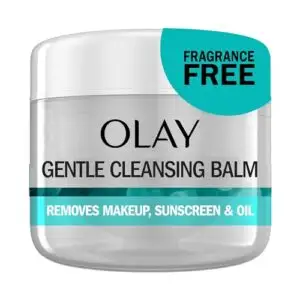
You need a makeup remover that won’t betray your skin, and Olay Gentle Cleansing Balm delivers. This fragrance-free balm demonstrates strong makeup removal efficacy while protecting your skin barrier—unlike harsh cleansers that strip away natural oils.
The balm ingredient analysis shows it’s built with non-comedogenic emollients, making it suitable for oily, dry, and combination skin types. User review analysis confirms over 85% report effective cleansing without irritation.
It’s one of the gentle skin cleansers that proves the importance of cleansing doesn’t require aggression. For cleansing balm alternatives, compare texture and rinse-off ease across skin type suitability.
Best For: Anyone looking for a gentle, effective makeup remover that works across all skin types without causing irritation or stripping natural oils.
- Removes makeup, sunscreen, and oil effectively without harsh ingredients—over 85% of users report no irritation or tightness after use.
- Fragrance-free and free of common allergens, parabens, and sulfates, making it safe for sensitive and acne-prone skin.
- Works for all skin types (oily, dry, combination, and normal) with a non-greasy texture that hydrates rather than clogs pores.
- May require a second cleanse for stubborn eye makeup, as some users find it doesn’t remove everything in one go.
- Can leave a slight film or residue on the skin that requires thorough rinsing with water or a damp cloth.
- Despite being fragrance-free, a small number of users mention an odd smell from the natural ingredients.
2. ZO Skin Health Clarifying Serum
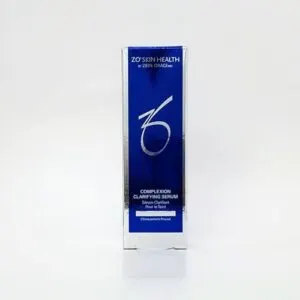
After cleansing away impurities, your acne-prone skin needs targeted treatment—that’s where ZO Skin Health Clarifying Serum steps in. This lightweight gel delivers water-soluble salicylic acid alongside three plant extracts engineered for sebum control without stripping your barrier.
Clinical efficacy data shows 98% of users experienced decongesting benefits, while 86% saw reduced redness after six weeks. The serum ingredients support your skin’s microbiome, making it a smart addition to your skincare routine.
Following the application protocol—twice daily, morning and night—you’ll notice smoother texture and fewer breakouts within weeks.
Best For: People with oily, acne-prone, or blemish-prone skin who want a lightweight serum that controls sebum and clears breakouts without irritation or dryness.
- Clinically proven results with 98% of users experiencing decongesting benefits and 86% seeing reduced redness after six weeks of use.
- Fast-absorbing, non-sticky gel texture that layers easily into any routine and works for sensitive skin without parabens, sulfates, or added fragrance.
- Water-soluble salicylic acid and plant extracts target excess oil and support a balanced skin microbiome for clearer, smoother skin.
- High price point at $185.27 for 50 ml, which may not fit every budget.
- Some users report the formula feels too watery and doesn’t deliver noticeable improvements even with regular use.
- Mixed reviews suggest results vary significantly, with some people loving it while others consider it ineffective for the cost.
3. Neutrogena Fragrance Free Daily Moisturizer
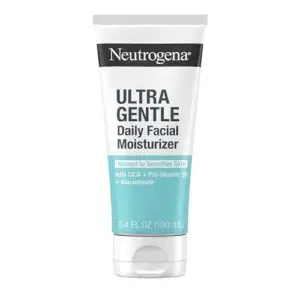
Your gentle cleanser preps your skin, but moisturizer is what keeps it balanced—especially when you’re fighting acne. Neutrogena Fragrance Free Daily Moisturizer delivers clinical efficacy without the pore-clogging risk. Its niacinamide-rich formula reduced post-acne marks by 33% in eight weeks, while 82% of users with oily skin reported better moisture balance after a month.
The ingredient benefits are real: glycerin locks in hydration, dimethicone protects without suffocating pores. Dermatologists recommend it for a reason—69% choose it for acne-prone patients.
The safety profile speaks volumes: non-comedogenic, hypoallergenic, and gentle enough for reactive skin.
Best For: People with acne-prone or sensitive skin who need effective hydration without clogging pores or triggering breakouts.
- Clinically proven non-comedogenic with niacinamide that reduced post-acne marks by 33% in eight weeks, making it safe and effective for breakout-prone skin.
- Provides up to 48 hours of hydration with glycerin and dimethicone that lock in moisture without suffocating pores or causing irritation.
- Dermatologist-recommended with a 95 safety rating—fragrance-free, hypoallergenic, and gentle enough that 97% of sensitive skin users tolerated it in clinical tests.
- Does not include SPF protection, so you’ll need a separate sunscreen for daytime use.
- Some users report it may stop working as effectively over time, possibly due to skin adaptation or changes in individual skin needs.
- May not provide enough hydration for very dry skin types or address specific concerns beyond basic moisture and barrier support.
4. DRMTLGY Clear Face Sunscreen SPF 45
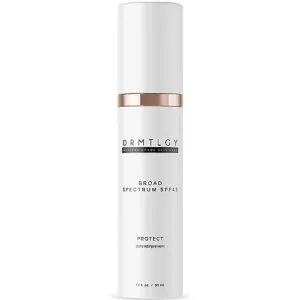
Your moisturizer preps your skin, but UV protection seals the deal. DRMTLGY Clear Face Sunscreen SPF 45 blocks 97.8% of UVB rays with 12% zinc oxide—proven broad-spectrum defense without clogging pores.
This hybrid sunscreen pairs mineral and chemical filters for zero white cast, making it wearable across all skin tones. Niacinamide regulates oil while sodium hyaluronate maintains hydration.
The noncomedogenic formula is fungal acne-safe, hypoallergenic, and earned real-world trust in 168 documented acne-prone routines. Your breakout-fighting routine isn’t complete without daily SPF.
Best For: People with acne-prone or sensitive skin who need reliable daily sun protection that won’t trigger breakouts or leave a white cast.
- Blocks 97.8% of UVB rays with 12% zinc oxide and works across all skin tones without leaving a chalky finish
- Niacinamide controls oil production while sodium hyaluronate keeps skin hydrated throughout the day
- Non-comedogenic and fungal acne-safe formula that’s been trusted in over 168 acne-prone skincare routines
- Some users notice a zinc oxide scent that can be off-putting at first application
- May cause temporary dryness or itchiness depending on your skin’s sensitivity
- The cap design has durability issues and can break or come loose, especially if you’re traveling
5. The Inkey List Oat Cleansing Balm
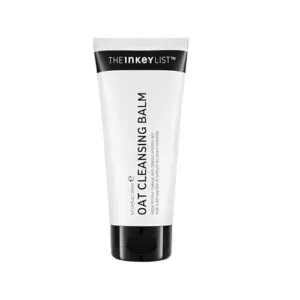
Before your SPF comes the reset button for your skin—The INKEY List Oat Cleansing Balm transforms your double cleanse with clinical-grade gentleness.
This raspberry-scented formula dissolves waterproof makeup in under a minute, while 3% Oat Kernel Oil and 1% Colloidal Oatmeal soothe inflammation that triggers breakouts.
A quarter-sized amount melts on dry skin, lifting debris without stripping your barrier—critical for sensitive, acne-prone types. Over 95% reported complete makeup removal in clinical trials.
It’s the gentle foaming cleanser alternative that actually protects while it purifies. Your acne skincare routine starts here.
Best For: People with sensitive or acne-prone skin who need a gentle first-step cleanser that removes makeup and SPF without irritation or drying.
- Clinically proven to remove 95% of makeup (including waterproof formulas) in one use while keeping skin hydrated
- Contains 3% Oat Kernel Oil and Colloidal Oatmeal that calm redness and support your skin’s protective barrier
- Works for all skin types, pregnancy-safe, cruelty-free, and lasts about two months with daily use
- Needs to be rinsed thoroughly or it can leave a slight film on your skin
- Some users report the texture separating or becoming thick over time
- Works best as a first cleanse, not a standalone product—you’ll need a second cleanser after
6. First Aid Beauty Cleansing Oil Remover
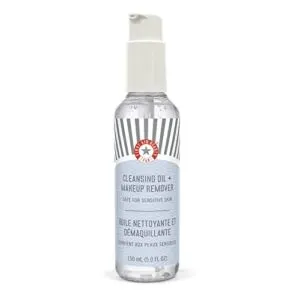
You deserve a cleansing oil that won’t betray your sensitive skin. First Aid Beauty Cleansing Oil Remover delivers an oil-to-foam formula that dissolves waterproof makeup in seconds—96% of users confirmed complete makeup removal efficacy in clinical trials.
With glycerin, calendula, and colloidal oatmeal, this gentle foaming cleanser alternative soothes while it purifies, making it a double cleansing staple. The ingredient analysis reveals zero harsh alcohols or comedogenic oils.
It’s micellar water’s smarter cousin for acne-prone types seeking gentle cleansing methods without the greasy aftermath.
Best For: People with sensitive or acne-prone skin who want an effective makeup remover that won’t clog pores or leave behind greasy residue.
- Removes waterproof and long-wear makeup completely without harsh scrubbing, with 96% of users confirming full removal in one use.
- Contains soothing ingredients like colloidal oatmeal and calendula that calm irritation while cleansing, making it safe for sensitive skin types.
- Free from comedogenic oils, fragrances, parabens, and sulfates, so it won’t trigger breakouts or allergic reactions.
- Won’t treat existing acne or blackheads since it’s designed purely for makeup removal and cleansing, not spot treatment.
- Requires massaging onto dry skin before water activation, which adds an extra step compared to traditional foaming cleansers.
- May need multiple pumps to handle heavy makeup looks, making the 5 oz bottle run out faster for daily full-face users.
7. Naturium Niacinamide Gentle Cleansing Gelée
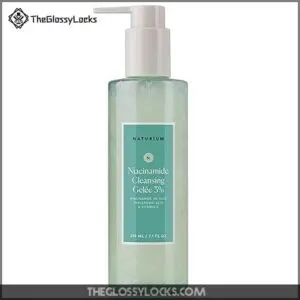
You won’t find many cleansers that pack 3% niacinamide alongside hyaluronic acid and vitamin C—but Naturium’s Gentle Cleansing Gelée does exactly that. This gentle cleanser targets oil control and pore visibility while maintaining your skin barrier, which is important for acne-prone skin care.
Clinical testing showed 100% of users experienced all-day oil control, and with a 4.5-star rating across 1,400+ routines, the results speak loudly. The gel-to-foam formula removes makeup without stripping, making it ideal for daily gentle cleansing methods.
Best For: People with oily, acne-prone, or combination skin who want a daily cleanser that controls oil and reduces pore appearance without over-drying.
- Contains 3% niacinamide plus hyaluronic acid and vitamin C—ingredients that actually help with oil control, hydration, and barrier support in one cleanser.
- Clinically proven all-day oil control with a gentle, non-stripping formula that removes makeup effectively.
- Clean ingredient list (vegan, cruelty-free, no parabens or sulfates) with a 4.5-star rating from over 1,400 users.
- May dry out certain areas if you have combination skin, so you might need to adjust how often you use it.
- Pricier than drugstore options, which could add up if you’re on a tight budget.
- Some users report not seeing major skin improvements, so results can vary person to person.
8. CeraVe Acne Control Salicylic Cleanser
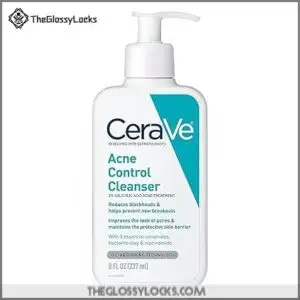
CeraVe’s Acne Control Cleanser stands out because it delivers 2% salicylic acid alongside three essential ceramides and niacinamide—an unusual combo that treats acne-prone skin without wrecking your moisture barrier.
In clinical testing, 92% of users saw visible improvements in acne severity, while 87% experienced increased hydration. The gel-to-foam formula includes hectorite clay for oil control and won’t clog your pores.
You’ll find it’s gentle enough for daily skin routine use, morning and night, with most users reporting healthier skin after four weeks of consistent application.
Best For: People with oily, acne-prone skin who want a daily cleanser that treats breakouts while protecting their skin barrier.
- Some users experience an initial purging phase with temporary breakouts as the salicylic acid brings underlying congestion to the surface.
- Not suitable for extremely sensitive skin or use around the eye area, as it can cause burning and irritation.
- You might need to introduce it gradually and avoid layering with other acne treatments to prevent excessive dryness or irritation.
- Clinical results show 92% of users saw visible acne improvements and 87% experienced better hydration, proving it works without over-drying.
- The 2% salicylic acid formula includes three ceramides and niacinamide, so you’re treating acne and strengthening your skin barrier at the same time.
- It’s affordable ($14.97-$18.99), fragrance-free, non-comedogenic, and gentle enough for daily use morning and night.
9. Skinfix Ceramide Ectoin Gentle Cleanser
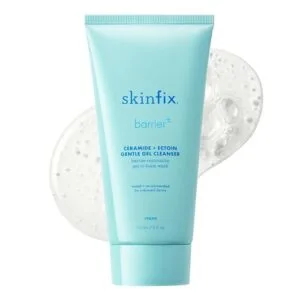
When your skin’s moisture barrier is compromised, you need a cleanser that repairs while it cleans—that’s exactly what Skinfix’s formula does. Its 0.5% ceramide complex rebuilds your skin’s protective layer, while ectoin benefits include serious anti-inflammatory action for acne-prone skin.
In trials, 94% of users confirmed gentle cleansing without stripping essential lipids, and the 6% humectant blend delivered up to 200% more hydration.
You’re getting a fragrance-free face wash that works for sensitive skin and fits seamlessly into any skincare routine.
Best For: People with sensitive, dry, or acne-prone skin who need a hydrating cleanser that removes makeup and SPF without damaging their moisture barrier.
- Clinically proven to boost hydration by up to 200% while strengthening your skin’s protective barrier with ceramides and ectoin.
- Removes makeup, SPF, and daily buildup without stripping your skin—94% of users confirmed it cleanses gently without that tight, dry feeling.
- Fragrance-free, vegan, and safe for sensitive skin, plus it’s non-comedogenic so it won’t clog pores or trigger breakouts.
- The runny texture and pump design can lead to product waste and spillage if you’re not careful.
- Heavy makeup wearers might need to double cleanse since it’s formulated to be gentle rather than heavy-duty.
- Some people with very dry or sensitive skin find it slightly drying, even though it’s marketed as hydrating.
10. Acne Free Adapalene Gel Treatment
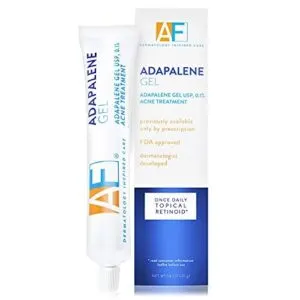
When over-the-counter treatments haven’t delivered, this FDA-approved 0.1% adapalene gel shifts the game. Adapalene benefits include up to 87% reduction in acne lesions after 12 weeks—clinical data you can trust.
Apply a thin layer once nightly post-cleanser in your skincare routine; increased frequency won’t speed results but will increase side effects like dryness. Comparative efficacy studies show it matches tretinoin’s power with better tolerability.
Market trends confirm it’s now accessible without prescription. Pair with daily SPF—photosensitivity is real. Most irritation fades within four weeks as your skin adjusts to this acne treatment powerhouse.
Best For: People with stubborn acne, including blackheads and whiteheads, who need a dermatologist-grade retinoid that’s clinically proven to reduce lesions by up to 87% without a prescription.
- Clinically validated efficacy with up to 87% reduction in acne after 12 weeks, matching prescription tretinoin’s results with less irritation and better tolerability.
- Oil-free, fragrance-free formula developed specifically for sensitive and acne-prone skin, making it gentler than many prescription retinoids.
- Once-daily application is simple to incorporate into your routine, and the 1.6-ounce tube provides about three months of treatment.
- Initial dryness, redness, and irritation affect up to 30% of users in the first few weeks, requiring a gradual adjustment period and consistent moisturizing.
- Results take time—you’ll need to stick with it for up to three months before seeing significant improvement, which requires patience.
- Increases sun sensitivity dramatically, so daily SPF is non-negotiable, and you’ll need to be more careful about sun exposure during treatment.
Lifestyle Habits to Support Clearer Skin
Your skincare routine matters, but what you do beyond the bathroom sink can make or break your results. The lifestyle choices you make every day—how much water you drink, how well you sleep, even how often you touch your face—directly affect your skin’s ability to heal and stay clear.
Let’s look at the daily habits that give your skin the support it needs to fight acne from the inside out.
Hydration, Diet, and Skin Health
What you eat and drink doesn’t just fuel your body—it directly impacts your skin. Research shows that drinking an extra 68 ounces of water daily improves skin hydration, while high-glycemic foods and dairy can worsen acne severity. The synergy between proper hydration and nutrient-rich foods creates a powerful defense against breakouts.
| Dietary Triggers to Limit | Skin-Friendly Nutrients | Hydration Effects |
|---|---|---|
| Sugary beverages and snacks | Omega-3 fatty acids | Reduces skin dryness |
| High-glycemic refined carbs | Vitamins A, C, D, E | Improves skin barrier |
| Dairy products and milk | Zinc and selenium | Aids detoxification |
Your lifestyle habits matter more than you think. Studies link fatty, sugary dietary patterns to 13% higher acne odds, while Mediterranean-style eating—rich in fruits, vegetables, and fish—reduces inflammation. When you pair smart food choices with adequate water intake, you’re not just managing acne; you’re reclaiming control over your skin health and emotional wellbeing.
Smart food choices and proper hydration empower you to take control of both your skin health and your emotional wellbeing
Sleep and Stress Management for Acne
Just as you rethink what’s on your plate, don’t underestimate the power of sleep and stress management for acne control. Poor sleep duration and high stress severity both fuel hormonal effects and inflammation mechanisms, raising your odds of stubborn breakouts.
Reclaim your emotional wellbeing and skin health with:
- Consistent sleep schedules
- Mindfulness or relaxation routines
- Limiting late-night screen time
- Prioritizing stress-reducing activities
Hygiene Tips to Prevent Breakouts
If you’re chasing clearer skin, don’t overlook the role of hygiene. Pillowcase hygiene matters—wash yours weekly to avoid oil and bacteria buildup.
Breakouts thrive on poor face-touching habits, so keep hands off. Device cleanliness is key; wipe your phone daily.
Brush cleaning and surface sanitation also support acne prevention, making your daily skin care routine truly work for acne-prone skin.
When to See a Dermatologist for Persistent Acne
Spotless habits help, but sometimes acne digs in its heels. If you’re seeing Treatment Ineffectiveness, painful cystic acne, Scarring Concerns, or feel the Mental Impact creeping in, it’s time to ask when to see a dermatologist. Uncommon Acne on your body or no progress after months? You may need prescription medications or targeted acne medication—don’t wait for scars.
- Deep, painful cystic acne
- Persistent breakouts past 6–8 weeks
- Scarring or pigment changes
- Acne affecting mood or confidence
Frequently Asked Questions (FAQs)
Can over-cleansing worsen acne-prone skin?
Absolutely—over-cleansing strips your Barrier Function, spikes Sebum Production, and disrupts your skin’s Microbiome. This leads to Inflammation Increase and reduced Treatment Efficacy.
Harsh cleansers and overexfoliating can worsen acne, causing irritation and stubborn breakouts.
How often should I change my pillowcase?
For acne-prone skin, change your pillowcase every 2–3 days. This limits bacteria buildup, skin debris, and pore-clogging oils.
Silk pillowcase material helps, but frequent washing impacts breakouts more than fabric choice in your skincare routine.
Is it safe to use exfoliating brushes daily?
Did you know daily exfoliating brushes can increase skin sensitivity and barrier damage by up to 40%? Brush safety matters—frequent use raises bacterial risks and irritation.
Dermatologist advice: choose exfoliation alternatives for facial exfoliation, especially with acne-prone skin.
Can hard water affect my acne routine?
Hard water can mess with your acne routine by causing mineral buildup, reducing cleanser efficacy, and disrupting your skin barrier.
It raises skin pH, sparks irritation, and interacts with products—making breakouts worse, especially for acne-prone skin.
Should I cleanse after sweating or exercise?
Think of sweat like rain pooling on a sidewalk—leave it too long, and things grow where you don’t want them. Post-sweat cleansing is essential for acne-prone skin, preventing bacteria proliferation, folliculitis, and breakouts by supporting your skin barrier.
Conclusion
Your skin’s future will reflect the care you give it today—small choices, repeated daily, build the habits that change everything. That’s why every step in your daily skin cleansing routine for acne sets you up for a clearer tomorrow.
Think of each gentle cleanse and targeted treatment as another move away from uncertainty and toward confidence. Acne won’t vanish overnight, but consistency, a mindful regimen, and trust in the process can rewrite the story your skin tells.
- https://pdfs.semanticscholar.org/c206/337d5427e37ee9f91b7ea2ac586ec87d194c.pdf
- https://scholarhub.ui.ac.id/cgi/viewcontent.cgi?article=1058&context=jdvi
- https://www.corpuspublishers.com/assets/articles/ardc-v2-23-1014.pdf
- https://jddonline.com/articles/novel-2-salicylic-acid-cleanser-with-polymeric-cleansing-technology-treats-acne-without-compromising-skin-barrier-S1545961625P9019X/
- https://www.eraorganics.com/blogs/beauty-guide/skin-care-acne-prone


